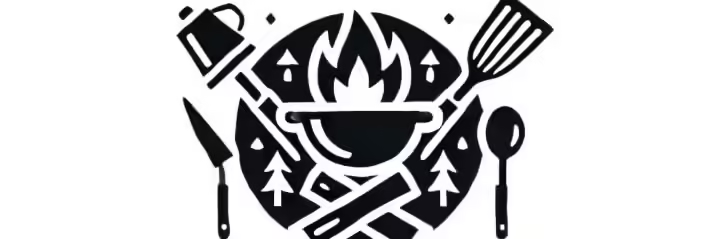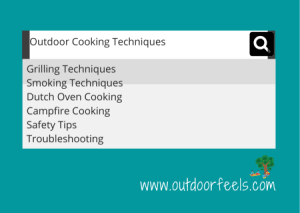Currently, outdoor cooking is a popular activity among foodies everywhere…
It offers a distinctive atmosphere with the incredible grill, smoky flavors, and the joy of gathering outside.
It enables you to discover various flavors, try out new cooking methods, and produce wonderful meals.
Here I have explained about outdoor cooking Techniques, its advantages, adventure, and the significance of learning various art to improve your meals…
Let’s explore the world of outdoor cooking together and learn skills that can make your meals better and spark your interests…;
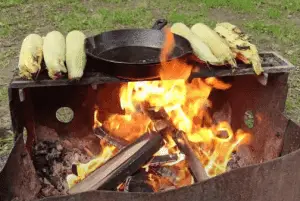
Recommended Reading:
– Outdoor Cooking Safety: Dive into my comprehensive guide on ensuring safety while enjoying the art of outdoor cooking. It’s a must-read for every outdoor enthusiast!
– Outdoor Cooking Accessories: Discover my handpicked list of essential accessories that can elevate your outdoor cooking experience. From grills to utensils, find out what you need for the perfect cookout.
– Outdoor Cooking Tips: Looking for ways to enhance your outdoor cooking skills? Check out my top tips and tricks that can make your next outdoor culinary adventure a resounding success!
# Types of Outdoor Cooking
For outdoor cooking you have so many and different cooking methods such as grilling, smoking, campfire cooking, and Dutch oven cooking..
Below I have explained briefly about cooking methods and their advantages and the types of foods they are best suited for..
Be Continued…
#Essential Tools or Equipment
Here are some equipment for outdoor cooking which you must have..
Grills
Features
- High-quality construction.
- Adjustable heat controls.
- Grates for versatile cooking.
- Easy-to-clean.
- Portable options available.
Benefits
- Versatility to prepare a variety of dishes.
- Grilling makes food taste better.
- Food cooks quickly which is very beneficial for outdoor cooking.
- A healthy method of cooking that removes excess fat from food.
Variations
- Charcoal grills provide a traditional smokey flavor.
- Gas grills for easy and accurate temperature control.
- Electric grills allow indoor and outdoor use.
- Pellet grills provide wood-fired flavor.
- Portable grills for traveling or outdoor cooking.
Recommended Reading:
– Best Charcoal Smoker
– Gas Grilling vs Charcoal Grilling
– Best Electric Pellet Smoker
– Best Electric Smoker for Beginner
– Best Gas Grill for your outdoor
– Best Pellet Smoker
Smokers
Features
- Insulated structure to maintain temperature and retain heat.
- Chimney or smoke vent for proper exit of smoke and airflow.
- Multiple cooking racks or shelves to cook huge amounts of food.
- Thermometers or temperature gauges to monitor cooking temperatures.
- Water pans for moisture.
- Drip pan helps to clean.
Benefits
- Provide a slow and low cooking method.
- Brings smokey flavors to cuisine.
- Versatility to prepare a range of dishes.
- Allows different types of wood for smoking.
Variations
- Offset smokers for typical smoking feature a separate firebox.
- Vertical smokers for small, space-saving smoking.
- Pellet smokers for simple temperature adjustment.
- For simple operation, use electric smokers.
- Barrel or drum smoker for a special cooking experience.
Recommended Reading:
– Best Offset smokers
– Top Vertical smokers
Camp stoves
Features
- Portable and small design simple to transit.
- Fuel-saving and portable for camping and camping trips.
- Adjustable flame management system.
- Sturdy construction.
- Wind- and weather-resistant for outdoor use..
Benefits
- An affordable cooking for adventure trips and camping.
- It cooks food fast and effectively.
- Ability to use a variety of fuels.
- Suitable for frying, grilling, simmering, and boiling water.
- Perfect for making hot drinks, dehydrated foods, and easy recipes.
Variations
- Propane camp stoves are easy to use since the fuel is widely available.
- Butane camp stoves for their portability and ease of setup.
- Liquid fuel camp stoves for versatility and extended use.
- Wood-burning camp stoves provide a traditional and healthy manner of cooking.
- Multi-Fuel camp stoves have a variety of fuel options.
Utensils
Benefits:
- Tools necessary for preparing, cooking, and serving food outside.
- Built with tough materials for prolonged use in harsh conditions.
- Enables quick and effective food handling while maintaining optimum hygiene.
- Various utensils are available for various cooking and serving purposes.
- Simple to maintain and clean for comfortable outdoor cooking..
Variations
- Grilling utensils: Specifically spatulas, tongs, brushes, and skewers are a few examples of grilling tools.
- Cooking utensils: Cooking tools include ladles, forks, spoons, and knives for use in cooking in general.
- Serving utensils: Utensils for serving to serve food, such as serving spoons, salad tongs, and serving forks.
- Specialty utensils: Unique tools with specialized uses, such as marshmallow roasting sticks, maize holders and seafood forks.
- Portable utensil sets: These sets are small and light, making them ideal for eating and cooking outside while on a trip..
Outdoor Cooking Techniques
# Grilling Techniques
Here some popular grilling techniques like-
Direct grilling
A common grilling method called “direct grilling” involves placing food directly over a high heat source..
It provides various–
Benefits
Fast and effective cooking: Direct grilling takes less cooking time and is ideal for preparing smaller quantities of meat, vegetables and shellfish.
Flavorful sear: High heat develops a great sear and browning on food, boosting flavor and adding a crispy coating.
Versatility: A variety of dishes, such as steaks, burgers, chicken breasts, veggies, and kebabs, can be cooked directly on the grill.
Easy to control: You can directly manage the heat by moving the food’s placement on the grill grate or by using your grill’s temperature control options.
When to use direct grilling:
Thin cuts of meat: Direct grilling is best for thin pieces that need to cook quickly, such as steaks, chops, and fish filets.
Foods that benefit from a charred exterior: Direct grilling is the best method for attaining the desired flavor if you like the smoky and charred tastes.
Fast cooking: Direct grilling is the best method for preparing food rapidly when you don’t have much time..
Indirect grilling
Indirect grilling is a method for cooking food that involves placing it near to the heat source rather than directly over it..
It has various–
Benefits
Even and gentle cooking: indirect grilling offers a more mild and uniform distribution of heat, for better control over the cooking process. Larger chunks of meat or delicate items that need more time to cook will especially benefit from this.
Enhanced tenderness and juiciness: Indirect heat assists the food retain moisture, producing tender and luscious results.
It is best suited for harder meat cuts that benefit from low and slow cooking.
Smoke infusion: Indirect grilling provides smoky flavor to produce a genuine barbeque using wood chips or chunks.
When to use indirect grilling:
Slow cooking: Indirect grilling is effective for slow-cooking big pieces of meat using smoking, roasting, or braising methods, such as whole chickens, roasts, or ribs.
Foods that require gentle heat: Indirect grilling prevents overcooking or burning from direct heat and allows precise, delicate cooking for delicate items like fish and vegetables.
Adding smoky flavor: Indirect grilling along with smoking methods are the best options if you want to give your food a smoky flavor.
Searing.
It requires roasting the food for a brief period of time over high heat in order to get a caramelized coating on the surface.
The advantages of searing and when to utilize it are as follows:
Benefits of searing
Flavorful crust: When food is seared, a rich caramelized crust forms, which improves flavor and adds a delicious texture.
Juicy interior: The natural juices are locked inside by swiftly scorching the food, leaving the interior wet and flavorful.
When to use searing:
Steak and meat cuts: Searing is the finest method for thick meat pieces like steaks because it produces a delectable surface without affecting the tenderness or wetness of the interior.
Burgers: Searing burgers can produce the required charred appearance while maintaining a juicy interior.
Seafood: Searing can generate a crispy surface while preserving a soft and moist interior in some shellfish, such as tuna or scallops.
Vegetables: Vegetables such as asparagus, zucchini, or peppers can also be roasted to add caramelization and bring out their natural flavor.
Following are some benefits and examples of foods that are best grilled:
The outdoor cooking method of grilling is adaptable, has a number of benefits, and works well for a variety of dishes. .
Advantages of grilling:
Enhanced flavor: Grilling enhances the flavor and aroma of food by giving it a distinctive smokey flavor.
Healthier cooking method: With grilling, excess fat can flow off the food, resulting in meals that are healthier.
Versatility: Foods like meats, vegetables, seafood, and even fruits are suitable for grilling.
Foods best suited for grilling:
Steaks and burgers: Burgers and steaks cook beautifully on the grill, with a deliciously browned skin and juicy interior.
Chicken and poultry: Grilling poultry and chicken results in juicy meat with a delicious, crispy exterior.
Vegetables: Vegetables like corn, bell peppers, zucchini, and eggplant taste sweeter and have a smokier flavor when they are grilled.
Seafood: When seafood, such as salmon, shrimp and kebabs, are grilled, their natural flavors are enhanced and imparted a delicious smoky flavor.
Fruits: Fruits like pineapple, peaches, and watermelon taste sweeter after being grilled because the sugars caramelize.
# Smoking Techniques
Let’s explore the flavorful world of outdoor smoking with a variety of smoker styles, including as offset, vertical, and pellet smokers.
To enhance the taste of smoking, you have to choose the right wood. Also, it is important to know which wood flavor is suitable for which food. To enhance your outdoor cooking experience, experiment with different types of wood.
To achieve optimal results in smoking techniques, it’s important to master temperature control. Here’s how:
- Adjust airflow: Increase or decrease air flow and oxygen levels to replace heat by adjusting vents or dampers.
- Use a thermometer: Using a thermometer, precisely measure the temperature within your smoker.
- Preheat and stabilize: After heating your smoker to the desired level, make slight adjustments to stabilize the temperature.
- Manage fuel and wood: For the desired temperature, manage your fuel and wood consumption.
- Adjust cooking chamber: To adjust temperature, move the meal nearer or away from the heat source.
- Check and maintain: Throughout the smoking process, keep an eye on the temperature and make any required modifications.
Tips for achieving tender and smoky results.
- Choose the right cut: To ensure tender and delicious results, choose fatty meats like ribs, brisket, or pork shoulder for slow smoking.
- Patience is key: For a delicate, flavorful meal, cook it gently and slow. Patience is necessary to tenderize the meat and give it a nice smoky flavor.
- Use a dry rub: Before smoking, give the meat a delicious dry rub to improve its flavor. The rub creates a lovely crust on the outside of the meat and adds a layer of spice.
- Monitor the smoke: To keep a consistent smoke for the ideal smoky flavor, add wood chips or chunks.
- Maintain consistent temperature: For even grilling and delicious meat, keep the smoker’s temperature constant.
- Rest before serving: For juicier, more delicious results, allow the smoked meat to rest gently.
Here are several benefits and meal ideas that make smoking methods a flexible and delectable choice for outdoor cooking..
Advantages of Smoking Techniques:
- Enhanced flavor: Smoking gives food a great smokey flavor and makes meat more soft and juicy.
- Versatility: You can smoke a vast variety of items, including meats, poultry, fish, and even vegetables etc.
Types of Foods Best Suited for Smoking:
- Meats: Meats such as ribs, brisket, pork and chicken, as well as fish and seafood such as salmon, trout and shrimp, are best for smoking.
- Vegetables: Vegetables including corn, peppers and eggplant can acquire a distinctive smoky flavor when smoked.
# Roasting and Spit-Roasting
Spit-roasting and roasting provide a variety of mouthwatering, juicy culinary delights.
To achieve flawless results, mastering roasting and spit roasting calls for careful attention to flavor, temperature, and cooking periods.
Proper Seasoning: To improve the flavors of meats and vegetables, thoroughly season them with herbs, spices, and marinades.
Temperature Management: For consistent and desired cooking outcomes, keep the temperature constant throughout roasting.
Cooking Times: To ensure that different types of meat and vegetables are cooked to perfection, offering both tenderness and mouthwatering flavor, be aware of the appropriate cooking times.
Benefits and the kinds of foods they are most suitable for..
Advantages and food pairings:
Roasting and spit-roasting produce juicy meats and vegetables with smokey flavors and crispy exteriors.
These methods provide savoury and delectable results and are ideal for whole birds, roasts, vegetables, and kebabs..
# Dutch Oven Cooking
The flexibility of cooking in a Dutch oven for outdoor enthusiasts.
- Since Dutch oven cooking is so adaptable, you can use it in a variety of outdoor situations and activities.
- It offers a variety of cooking options, including baking, roasting, simmering, stewing, and even frying.
- Dutch ovens are perfect for outdoor activities like camping and picnics since they are lightweight and portable.
- They can handle high temperatures, work with charcoal, wood, and campfires.
- Because Dutch ovens hold heat well, food cooks evenly and consistently.
- You can use a Dutch oven for a variety of savory and sweet dishes, such as breads, desserts, meats, soups, and casseroles.
- Dutch ovens provide a tasty outdoor cooking experience, with countless recipe options and cooking methods to experiment.
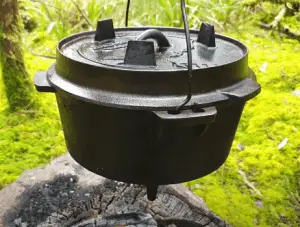
I’m going to share several recipes and methods right here for baking, braising, and stewing in a Dutch oven.
Baking in a Dutch Oven:
- Get the Dutch oven ready or preheat.
- Prepare the batter or dough..
- Throw the dough or batter in the warmed Dutch oven.
- Seal the dish with a lid and bake for the allotted time.
- Use a toothpick or skewer to check whether the stuff is cooked.
Braising in a Dutch Oven:
- Preheat your Dutch oven.
- The meat or veggies are season and sear.
- Liquid and aromatics should be added.
- Cover and cook on low flame for the specified time.
- Use a fork to test the meat for tenderness.
Stewing in a Dutch Oven:
- Preheat your Dutch oven.
- Brown the meat and sear the vegetables.
- Seasonings and liquid should be added.
- Cover and cook on low flame for the specified time.
- Verify that the meat is tender and the vegetables are cooked through.
Note: Customize the cooking process and temperature to the particular recipe and the intended outcomes.
Benefits and the kinds of foods they work best with.
Advantages of Dutch Oven Cooking:
- Versatility: With a Dutch oven you can use a variety of cooking methods, such as baking, braising, stewing, and frying.
- Even Heat Distribution: A Dutch oven’s sturdy sides and tightly fitting cover help it to distribute heat evenly.
- Retains Moisture: The tight lid’s capacity to hold in steam preserves the meal’s moist and flavor.
- Durability: Dutch ovens are made of cast iron, which makes them strong and long-lasting.
Types of Foods Suited for Dutch Oven Cooking:
- Breads and Baked Goods: Dutch ovens are ideal for baking bread, rolls, cakes, and even pizza.
- Braised Meats: Slow braising in a Dutch oven is beneficial for tough cuts of meat like pot roasts and short ribs.
- Stews and Soups: You can try broiling hearty stews, soups and chili in a Dutch oven, which develops a deep flavor and tender texture.
- One-Pot Meals: If you like one-pot meals like casseroles, risotto, and paellas, you can cook in a Dutch oven, as it cooks great.
# Campfire Cooking
When food is cooked outdoors over an open fire, it is magical. An absolutely amazing meal experience in the great outdoors is created by the mesmerizing flames, aromatic flavors, and traditional setting.
Here are some tips for building and maintaining a campfire.
- Choose a safe location: Pick a location that has enough airflow, is away from combustible materials, and abides by any local rules.
- Prepare the fire pit: Remove any clutter from the area and, if there is one available, use rocks to make a fire pit.
- Gather the right wood: Gather a variety of sizes of dry, seasoned firewood, along with tinder, kindling, and fuel.
- Build the fire: Start burning with small pieces of wood, then add bigger logs as the fire grows.
- Maintain the fire: Add more fuel logs to the fire as needed. You can use a poker or stick to rearrange the logs.
- Extinguish the fire safely: Before leaving the area, extinguish the fire with water and check if there is any fire in the ashes.
Check out these quick ideas and delicious recipes for foil-packaged meals and campfire desserts:
Foil Packet Meals
- You can use heavy-duty aluminum foil to avoid tearing and ensure good cooking.
- You can seal food tightly, it lets steam and flavor through.
- You can place the foil packet over the coals or grill as needed.
- Here are some recipes which you can cook in foil.
Sausage and Veggie, Shrimp Pasta, Cajun Shrimp Boil, Poblano-Potato, Grilled Lemon Herb Chicken and Veggies, Campfire Cones, French Toast, Chicken Fajita, Bacon Ranch Chicken etc.
Campfire Desserts
You can prepare gooey s’mores or grilled fruit desserts and campfire Apple Crisps by adding chopped apples, oats, brown sugar, and butter to a foil packet.
Sometimes if you want to roast some food like marshmallows, keep the skewers with you.
Cooking over a campfire has some special benefits and works well with a variety of meals.
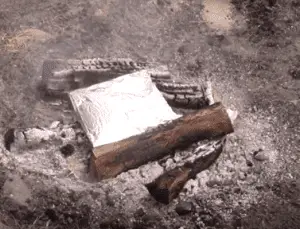
Here are some real benefits and food ideas:
Advantages:
- Improves Flavor: When you cook the dishes on an open fire, it gives a charred flavor which tastes very good.
- Versatility: There are several ways to prepare food over a campfire, such as smoking, roasting, baking, and grilling.
- Allows you to connect with nature: It is a very different experience to eat inside the room and outside the house. Campfire cooking gives you a chance to enjoy nature
- Simple to use: You can enjoy campfire cooking using minimum equipment and ingredients.
Food Recommendations:
- Grilled Meats: You can enjoy a campfire with grilled meats like Stocks, Burgers, Sausages, and Kabobs.
- Foil Packet Meals: You can easily cook vegetables, meat by using foil packets. I have already mentioned some names of foil packet meals, you can read them.
- Campfire Stews and Soups: here are some list of Stews and Soups-
Classic Beef Stew, Vegetable Stew, Corn Chowder, Chicken Noodle Soup, Campfire Chili, Potato Leek Soup, Sausage and Bean Stew, Clam Chowder, Minestrone Soup, Lentil Soup etc. - Grilled Vegetables: Also available as delicious side dishes are fire-fried veggies like corn on the cob, bell peppers, zucchini, and mushrooms.
- Campfire Desserts: I have already explained about campfire desserts.
Here are some campfire desserts:
Campfire s’mores dip, s’mores, campfire popcorn, campfire banana boats, campfire banana splits, Dutch oven peach cobbler, campfire berry parfait, campfire apple crisp, campfire pound cake etc.
# Outdoor Pizza Making
I’ve already covered how to make dough, several pizza oven designs, and methods for creating crunchy crusts and melted toppings. Visit this provided link for further details. Happy baking pizza!
# Safety Tips
Safety is of utmost importance when it comes to outdoor cooking.
Following are some crucial recommendations and safety rules:
Proper Food Handling:
- Keep cooked and uncooked food separate to avoid cross-contamination.
- You must use distinct appliances and cutting boards for raw and cooked foods.
- You should always wash your hands before and after handling food.
Fire Safety:
- You must choose a specific cooking area that is safe and free of explosives.
- Keep a water bucket or a fire extinguisher nearby for emergency situations.
- Extinguish the fire properly before leaving those fireplaces.
Equipment Maintenance:
- To prevent damage, clean your cooking equipment regularly and check it periodically for condition.
- To use and maintain a product properly, follow the manufacturer’s instructions.
- If you are not currently using your utensils, keep them in a dry and safe place.
Food Hygiene:
- Foods must be properly cooked inside in order to prevent foodborne illness.
- Keep perishable food in the refrigerator if you’re going to be cooking late.
- Do not mix raw and cooked foods, you should keep them separately to avoid cross-contamination of food.
Responsible Outdoor Cooking:
- Enjoy outdoor cooking without destroying nature. Follow the rules made for the betterment of nature.
- Maintain a clean and clutter-free cooking space by properly disposing of waste and food residues to reduce environmental impact.
# Troubleshooting
Here are some helpful hints and solutions for problems an outdoor cook may encounter:
Uneven Heat Distribution:
- For offset smokers, always have extra fuel to maintain the temperature. Similarly, learn how to adjust the temperature setting of electric and pellet smokers or burners to get the required temperature.
- You can use a heat deflector or rotate the food to distribute the heat more evenly.
- Indirect cooking methods are also helpful in maintaining the temperature.
Avoid Flare-ups:
- To prevent flare-ups, remove extra fat from meats.
- Avoid spilling excessive oil or marinade into the fire.
Maintaining Consistent Temperatures:
- Use a reliable thermometer, and have extra fuel on hand for offset smokers to monitor temperature.
- Burner controls or air vents can help you to adjust the temperature.
- It may be necessary to add charcoal or adjust the oxygen flow to maintain proper temperature.
Do not let the food stick:
- Before placing food on your grill, preheat it.
- Apply oil or nonstick frying spray to the grates to avoid sticking.
- You can scrape or loosen the stuck food with a spatula.
- Do not keep turning the food too much.
How to avoid excessive smoke:
- To reduce the amount of smoke, adjust the airflow.
- You can use a smokeless griller.
- Select the right coal.
- Set the temperature in the control panel given in the smoker according to the need.
# Recipe Inspiration:
Here are a few delicious and easy outdoor cooking recipes for readers to try:
- Grilled lemon herb chicken
Marinate chicken breasts in a mix of fresh herbs, garlic, lemon juice, and olive oil.
Grill the chicken until it is thoroughly done, juicy, and tasty over medium heat.
- Foil packet vegetables
Add olive oil, salt, and pepper to a mixture of your preferred vegetables, such as bell peppers, zucchini, and mushrooms.
Vegetables should be put in a foil packet and sealed well.
Until the vegetables are soft and lightly browned, grill the packet over medium-high heat.
- Smoked salmon with dill
Use salt, pepper, and fresh dill to season fresh salmon fillets.
For a smoky flavor, smoke the salmon using wood chips on a preheated grill or in a smoker.
Cook the fish until it is fully done and flaky.
- Grilled pineapple with cinnamon
Slice up fresh pineapple into rings and add ground cinnamon.
Over medium heat, grill the pineapple rings until they are soft and caramelized.
How do I make sure everyone has a delicious and satisfying culinary experience?
It’s crucial to have a variety of meals when organizing outdoor cooking in order to accommodate various palates and dietary requirements.
Provide choices for meat eaters, vegans, and anyone with dietary limitations.
To provide a well-rounded outdoor dining experience, include sides, salads, and desserts.
By doing this you can ensure that everyone has a delectable and fulfilling outdoor culinary experience.
# Frequently Asked Questions
# How long should I grill a steak to get medium-rare?
Depending on the thickness of the steak, sear it on the grill for 4-5 minutes per side for a medium-rare steak.
Make sure the internal temperature of the meat is 135°F (57°C).
# What is the ideal internal chicken temperature?
Chicken should be cooked to a temperature of 165°F (74°C).
Check the temperature at the chicken’s thickest area using a meat thermometer.
#What should I do to avoid grilling flare-ups?
Keep a water spray bottle available to douse flames in order to prevent flare-ups.
Use Lean slices, and avoid excessive marinating or sweet sauces.
# What should I do if my grill’s heat distribution is uneven?
If your grill is not heating evenly-
Check the burners or coals to see whether they are clean and placed properly.
Use indirect heat to ensure more even cooking.
To equalize the distribution of heat, change the hob or airflow controls.
# How can I fix a charcoal barbecue that won’t keep lit?
Clean up the ash and open the vents to make sure there is enough airflow.
Verify that the charcoal is evenly spread and burning properly.
For more consistent and reliable charcoal ignition, use a chimney starter.
# What temperature should I grill burgers at?
Burgers should be grilled at a temperature of 350°F to 400°F (175°C to 200°C). For medium doneness, cook the burgers for around 4-5 minutes on each side.
# How can I avoid having my fish stick to the grill grate?
Before cooking, ensure the grill grates are clean and well-oiled to avoid fish sticking to them.
Flip the fish gently using a grill basket or a fish spatula.
Furthermore for simpler flipping, you can grill fish on a cedar plank or aluminum foil.
# How long should grilled meats sit before serving?
After grilling, it is advised to let the meat rest for 5 to 10 minutes.
# How can I regulate the heat on a charcoal grill?
To regulate the temperature on a charcoal barbecue adjust the airflow by opening or closing the vents..
While covering the vents prevents airflow and reduces heat, opening them lets more oxygen in and raises the temperature.
# What are a few tips for grilling veggies?
- Preheat your grill.
- To avoid sticking, lightly oil the vegetables.
- For consistent cooking, cut veggies into equal-sized pieces.
- To prevent smaller pieces from falling through the grates, use a grilling basket or skewers.
- Grill the food until it is soft and slightly scorched.
Conclusion
Outdoor cooking provides endless culinary enjoyment by connecting with nature..
This article explained roasting, Dutch oven cooking, campfire meals and grilling techniques.
I encourage you to experience all of these cooking techniques.
Try new cuisines, explore adventures and improve your culinary abilities..
Enjoy the delight and joy of outdoor cooking…
